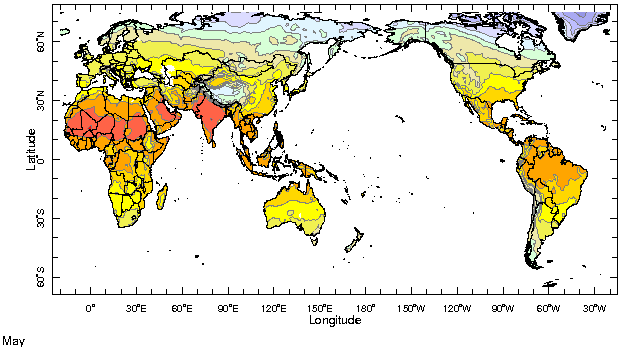|
IRI Climate Digest
June 2006
May Global Climate Summary
Climatological Background
In May, the sun is well into its march north of the equator (the maximum northward location will be achieved in June at 23.6 degrees north). Surface heating of the continents is setting the stage for summer monsoonal systems or Northern Hemisphere warm season rains. The lack of direct solar heating in the Southern Hemisphere creates a north-south temperature difference which strengthens mid-latitude storm tracks with the approach of winter.
Monthly Mean Temperature (1961-1990), data from the Climate Research
Unit, University of East Anglia


Monthly Mean Precipitation (1961-1990), data from the Climate Research
Unit, University of East Anglia


Temperatures
From southern Europe to North Africa, temperatures remained above average during May. Unusually warm conditions were also experienced over much of southwest Asia from southern Kazakhstan to the Arabian Peninsula. In North America, temperatures were well above average across the southwest US into northern Mexico and well to the north, across eastern Canada. In a notable departure from recent trends, many Southern Hemisphere land areas saw temperatures well below average during May, including much of western Brazil, southward to Uruguay, Paraguay, and northeastern Argentina, and in southern Africa and most of eastern and central Australia (Temperature Percentiles Map).
Temperature Difference from the 1961-1990 mean, with data
from NCEP Climate Prediction Center, CAMS.


Precipitation
The atmospheric circulation in May favored above-average rainfall across central Europe, but southern Europe and the Mediterranean were unusually dry. To the south, in West Africa, the early part of the rainy season was mixed, with above-average rainfall confined mainly to areas along the Guinea Coast. In East Africa, above-average rainfall in several locations of the Greater Horn resulted in localized flooding. There was above-average rainfall across the Indian subcontinent in May, marking a healthy start to the southwest monsoon. Below-average rainfall across eastern Australia, in southern Queensland and much of New South Wales contributed to ongoing dry conditions. Unusually dry conditions prevailed over southern Brazil, with above-average rainfall along the northern coast. In the northeastern US, portions of central New England experienced extremely heavy rainfall in May, resulting in some of the worst flooding there in 70 years.
Precipitation Difference from 1979-2000 mean, with data
from NCEP Climate Prediction Center, CAMS-OPI.


Oceanic Conditions
Sea surface temperatures in the east-central tropical Pacific continue to show near-neutral conditions. In the tropical North Atlantic, above-average temperatures have persisted across much of the basin. Conditions in the tropical Indian Ocean are generally near average. In the extratropics, below-average sea surface temperatures persisted across the Indian Ocean south of Australia and southeast of South Africa. Sea surface temperatures were well above-average in a broad band east of Madagascar in the extratropical Southern Indian Ocean, to the east of New Zealand in the South Pacific, and in the central South Atlantic (Standardized Sea Surface Temperature Anomaly Map ).
Monthly Sea Surface Temperature Difference from the 1971-2000 mean,
with data from the Environmental Modeling Center, NCEP/NOAA.


Contents |
Special |
Impacts |
Climate |
Forecast
|

